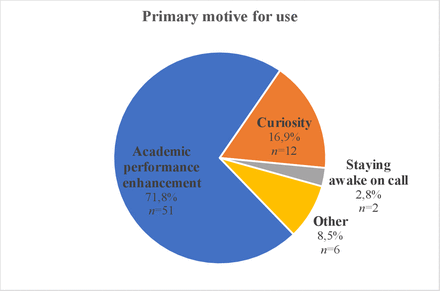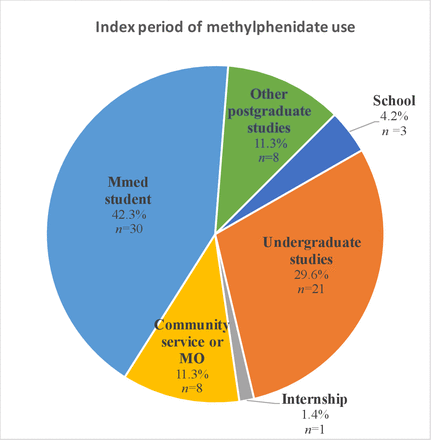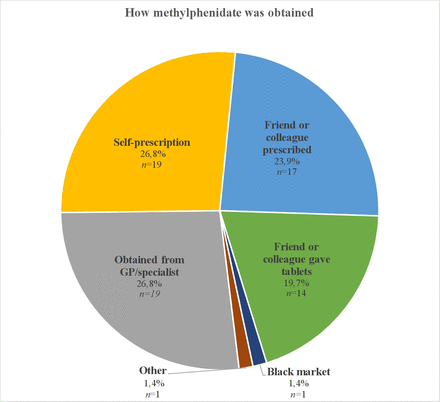Introduction
Methylphenidate is classified as a central nervous system stimulant and is chiefly used in the management of attention-deficit/hyperactivity disorder (ADHD).1 Clinically, the desired effects are decreased hyperactivity and distractibility, increased attentiveness and reduced impulsivity.2 3 Mild euphoria, a decreased sense of fatigue as well as an increased completion of tasks are associated benefits.2 These clinical effects have been shown to improve cognition if there is pathology rendering it suboptimal.4 The effect of increased attentiveness and ability to concentrate leads to the potential of methylphenidate being used for off-label purposes. Students use it mainly for academic purposes, especially during periods of high academic stress.5 ‘Academic purposes’ as noted here, alludes to the attempt at an increase in concentration, attention and alertness, with a hopeful improvement in academic performance while combating mental fatigue.
Current literature is inconclusive on whether psychostimulants, such as methylphenidate improves cognition in healthy individuals and suggests that the subjective impression that cognition is improved should rather be attributed to a feeling of well-being or euphoria being induced.4 6
The prevalence of ADHD in the general adult population is 2.5%, yet methylphenidate use by university students for off-label purposes is widely reported in international and South African literature with self-reported lifetime prevalence of psychostimulant use ranging from 5% to 35%.7–17 No investigation on the prevalence of methylphenidate use among postgraduate students has been previously published.
Jain et al and Retief and Verster recently evaluated the self-reported use of psychostimulants by undergraduate medical students at South African universities. Jain et al found that the prevalence of methylphenidate use was 11% while Retief and Verster concluded that 18% had a lifetime prevalence of psychostimulant (including methylphenidate, dextroamphetamine, pemoline and modafinil) use.12 14
Generally considered a safe drug, methylphenidate causes a modest increase in average blood pressure and heart rate, although there is a wide inter-individual variation in response.2 Even slight changes in baseline heart rate and blood pressure may cause significant morbidity or even mortality in individuals with ventricular arrhythmias, ischaemic heart disease or hypertension.2 Long-term side effects in the adult population have not been fully evaluated, but individual case reports have shown an association with myocardial ischaemia and increased risk for sudden cardiac death.18 19 It is advised that baseline blood pressure and heart rate be measured prior to initiation of methylphenidate therapy, with dose increases and periodically during therapy.2
Psychiatric side effects include irritability, anxiety, tics and psychosis.2 Severe depression may also ensue on sudden discontinuation.2 This is especially relevant in the student population as the majority use it only during high-stress periods, such as examinations.12 Furthermore methylphenidate has a high potential for dependence. Physical dependence is not common at usual therapeutic doses, but psychological dependence may develop with long-term use.2 3
The present research aims to investigate the prevalence of methylphenidate use, but also attempts to gain insight into the means of access and motivation for its use.
Objectives
The objective of this study was to provide a summary of the self-reported prevalence and correlates of methylphenidate use by Masters of Medicine (MMed) students registered at the Faculty of Medical and Health Sciences at a South African university.
Methods
Study design and setting
A cross-sectional study was performed using an anonymous online survey tool.
Study population
The target population included all students, across all specialties, registered for the MMed programme at the Faculty of Health Sciences at a South African university. All MMed students are qualified medical practitioners studying towards qualifying as a specialist in various medical fields. Trainees are required to be registered as MMed students for four or 5 years depending on the field of specialisation. Various sittings of formal theoretical, oral and clinical examinations must be completed successfully before registration as specialist may ensue. There were no exclusion criteria. At the time of conducting the research there were 505 registered MMed students.
Questionnaire
The authors designed a literature directed questionnaire as no validated instrument to measure methylphenidate use exists. The questionnaire was designed on the REDCap Consortium (Research Data Electronic Capturing Consortium) system. Limited demographic data (gender, year of study and age category) were collected to ensure anonymity. The questionnaire included questions pertaining to use of methylphenidate, index period of use, frequency of use, primary and secondary purpose for use, ADHD diagnosis, method of obtaining methylphenidate and side-effects experienced. Many questions required a single most applicable answer, while other allowed for ranking of preferences. Participants could elaborate if ‘other’ was selected as an option.
Data collection
A link to the anonymous, self-administered questionnaire was emailed to all registered MMed students. Data collection took place from 1 to 27 September 2020. After the initial invitation weekly reminders were sent to all registered students for 3 weeks. The anonymous responses were securely stored on the REDCap system.
Statistical analysis
Data were exported from REDCap to Microsoft Excel. Statistical analysis was done using Stata V.16. Categorical variables were summarised by count (percentage). Continuous variables were summarised with mean (SD). We report prevalence by point estimate with the corresponding 95% CI. Test associations on demographics were reported on using logistical regression models with a p value of <0.05 considered as statistically significant.
Results
Demographic data
The electronic questionnaire was distributed to the 505 registered MMed students at a single South African university. The response rate was 50.1% with 253 completed questionnaires. Of these 118 (46.6%) were male and 135 (53.4%) were female. The highest percentage of respondents was from students in their fourth year of study (24.9%) and in the age group 30–35 years old (68.4%). Table 1 highlights the demographics of the respondents.
Demographic data of respondents
Prevalence and ADHD diagnosis
Overall, 28.1% (n=71; 95% CI 22.52 to 33.60) of respondents reported having used methylphenidate while only 2.4% (n=6) have been formally diagnosed with ADHD. A further 11.7% think that they may potentially have ADHD, but have not been diagnosed. More than half of the respondents (n=135; 53.4%, 95% CI 47.2 to 59.5) know of an MMed registered student using methylphenidate for academic purposes. The study cohort correlated well to the population investigated. There was no statistically significant difference (p=0.151) between male (n=28; 39.4%) and female (n=43; 60.6%) respondents using methylphenidate. We were unable to demonstrate any statistically significant difference (p=0.288) in usage among different age categories (<30 n=4; 5.6%, 30–35 n=55; 77.5% 36–40 n=10; 14.1%,>40 n=2; 2.8%). We were also unable to demonstrate any statistically significant difference (p=0.149) in usage among students in different years of study (year 1 n=10; 14.1% year 2 n=17; 23.9% year 3 n=15; 21.1% year 4 n=17; 23.9% year 5 n=12; 16.9%).
Use for postgraduate academic purposes
More than a fifth (21.3%; n=54) of respondents to the questionnaire have used methylphenidate while being registered as an MMed student. Improvement of academic performance (71.8%) was the most common primary reason for using methylphenidate, followed by curiosity (16.9%)—indicated in figure 1. More than three quarters (76.1%, 95% CI 66.13 to 85.98; n=54) of lifetime methylphenidate users used it while being registered as an MMed student with nearly half (45.1%; n=32) using it in the year leading up to data collection. Figure 2 indicates the index period of use for 42.3% (n=30) was while being registered as an MMed student whereas 29.58% (n=21) started while being undergraduate students and only 3 (4.2%) while at school.
Frequency of use
Methylphenidate was used sporadically by 32.4% (n=23) of users while 23.9% (n=17) used it daily. Less than a third (29.6%) of life-time users used it once-off only. The rest of the users used it once per week (8.5%), once per month (4.2%) or once per year (1.4%).
How methylphenidate was obtained
Figure 3 indicates that methylphenidate was prescribed by a general medical practitioner or specialist to 26.8% (n=19) after a consultation. Equal numbers of participants report self-prescription. A prescription for methylphenidate was obtained from a colleague without a formal consultation by 23.9% (n=17) while 19.7% (n=14) received the medication from a friend or colleague to whom it was legally prescribed.
Side-effects and risk
More than two-thirds (70.4%, n=50) of users reported side-effects with insomnia (35.2%), anxiety (33.8%) and palpitations (32.4%) most frequently occurring. Withdrawal symptoms developed in six (8.5%) respondents on discontinuing methylphenidate. The majority (71.2%, n=180) of all respondents believed that methylphenidate use has both physical and psychiatric risk. Much smaller groups believed that there is no risk at all (9.9%, n=25), risk isolated to mental health (11.9%, n=30) and risk limited to physical health (7.1%, n=18).
Discussion
In this cohort methylphenidate had a lifetime prevalence of 28.1% with more than a fifth of respondents using it while being registered as an MMed student. The prevalence of use in our population is much higher than reported in undergraduate South African medical students or in international students.9–12 14 In our study population only 9.5% of users started using methylphenidate during or prior to their undergraduate medical studies. However, 42.3% started using methylphenidate for the first time while being registered as an MMed student.
We conclude that off-label use is rife in our study population as the prevalence is 11.7-fold higher than the diagnosis of ADHD.
Numerous factors could contribute to the increased prevalence of use in MMed students. Ease of access is one of these. Self-prescription and prescription by a friend or colleague without consultation contributed significantly to the manner in which methylphenidate was obtained. Undergraduate medical students would not be able to obtain methylphenidate in this manner. Jain et al reported in 2017 that 70.6% of undergraduate medical students at the University of the Free State obtained it with a valid prescription after consulting a medical doctor.12 In contrary only 26.8% of users in our population obtained it after formally consulting a general medical practitioner or specialist.
Methylphenidate, a schedule 6 drug, is generally considered a safe drug, but its use for purposes other than the registered indications, regular evaluation and follow-up may have serious adverse health consequences, especially if comorbid conditions (known or unknown) are present in individuals. The risk of sudden cardiac death or ventricular arrhythmia is close to double after methylphenidate initiation in adults.19 Development of psychosis has also been reported.2 The vast majority of respondents admitted to knowing that methylphenidate use may have both physical and psychiatric risks. It is thus worrisome that almost three-quarters of users obtained it without a medical consultation. Being a schedule 6 drug methylphenidate should be a highly controlled substance. The authors found the ease of access concerning and believe it warrants the necessary attention of the relevant authoritative bodies and regulatory agents.
The authors postulate that the high prevalence of methylphenidate use in this cohort is linked to the perception that MMed students have tremendous stress and pressure compounded by occupational and academic demand. This is supported by the sporadic use of methylphenidate during times of academic pressure by a third of users, the primary purpose of use being academic performance enhancement and that 42.3% of users in our population started using methylphenidate specifically for MMed academic purposes. This is indicative of the perceived benefit of methylphenidate to aid with cognitive function. However, current literature is inconclusive as to whether methylphenidate objectively improves cognition in healthy individuals and suggests that the subjective impression that cognition is improved should rather be attributed to the feeling of euphoria or well-being being induced.4 6 Students using methylphenidate may therefore expose themselves to serious potential adverse effects without any true benefit.
The perception of high pressure and demand on MMed students is supported by the reported prevalence of burnout among MMed students. Two South African studies have shown that the level of burnout in MMed students is higher than doctors who have not started specialising or have completed specialising and are working in similar environments.20 21 One South African university reported a burnout prevalence of 84% in their MMed population.22 Burnout leads to the reduction in ability to concentrate and students may attempt to pharmaceutically correct this. Although this cannot be directly extrapolated to our study population, it may be an indicator of a possible motive for using methylphenidate. Methylphenidate may however contribute to burnout by means of side-effects experienced. Insomnia occurs in more than a third of our cohort of methylphenidate users—exaggerating the subjective feeling of exhaustion and depleted energy levels and in effect contributing to the development of burnout in the predisposed individual.
Potential harm in the light of minimal evidence for cognitive benefit in healthy subjects places the user at risk while the prescriber is at medicolegal risk. This is even more true in the event of off-label prescription after consultation and prescription without a formal consultation—both frequent occurrences in our cohort. Professionalism of the prescriber may be in question. In traditional medicine off-label prescription for the treatment of disease would not be considered unethical although off-label prescription for the purpose of enhancement in the absence of disease may well be. Performance enhancement in sport as an example is globally prohibited—not only is it unethical, but also illegal. Morally it would be difficult to justify an attempt to enhance cognition in the student population where cognitive benefit is questionable and safety is not established. Future large randomised control trials should shed light on current lacking evidence, but until then the authors believe that the prescription of methylphenidate for performance enhancement, although not illegal, is not ethically justifiable.
Study limitations
Study limitations include the use of a non-validated self-administered questionnaire. Selective non-disclosure or dishonesty due to the sensitive nature of the topic could have affected the quality of the data. The data were collected at a single university and should not be extrapolated to other universities or fields of study.
Conclusion
This research demonstrates that the prevalence of methylphenidate use in our population is much higher than reported in undergraduate medical students and nearly 12 times higher than the prevalence of diagnosed ADHD. Academic performance enhancement is the most common primary reason for its use and acquisition is predominantly without a formal medical consultation. This is of great concern as methylphenidate is a schedule 6 pharmacological agent and should be highly regulated, not to mention the potential health consequences to the unmonitored user. We postulate that a combination of ease of access, added academic and work pressure and a high degree of burnout may contribute to the identified phenomenon. Efforts should be made to promote awareness of potential harm of methylphenidate with minimal evidence for cognitive benefit in healthy students, discourage self-prescription, increase access and knowledge of available psychological support to students in need and to develop interventions to limit non-conventional means of access.
Main messages
-
Methylphenidate use in MMed students is highly prevalent.
-
Academic performance enhancement is the most common primary purpose for use.
-
Acquisition is predominantly by non-conventional means.
Current research questions
-
Is the prevalence in our cohort different to other postgraduate populations or is this a global phenomenon?
-
Is there any objectively measurable cognitive benefit in students using methylphenidate compared with non-users?
-
What is the incidence of serious adverse events attributable to methylphenidate in the student population?
What is already known on the subject
-
Undergraduate student use of methylphenidate has been extensively researched with varying prevalence reported.
-
Postgraduate student use is not reported on previously.
Data availability statement
Data are available upon reasonable request. Not applicable.
Ethics statements
Patient consent for publication
Ethics approval
Ethical approval was obtained from the Health and Research Ethics Committee of the University of Stellenbosch (ref. no. S20/03/068). Institutional permission, to conduct research on registered students, was received from the Division of Institutional Governance of the University of Stellenbosch (ref. no. IRPSD-1844).
Acknowledgments
Dr Moleen Zunza from the division of Epidemiology and Biostatistics of the University of Stellenbosch assisted with statistical analysis.




